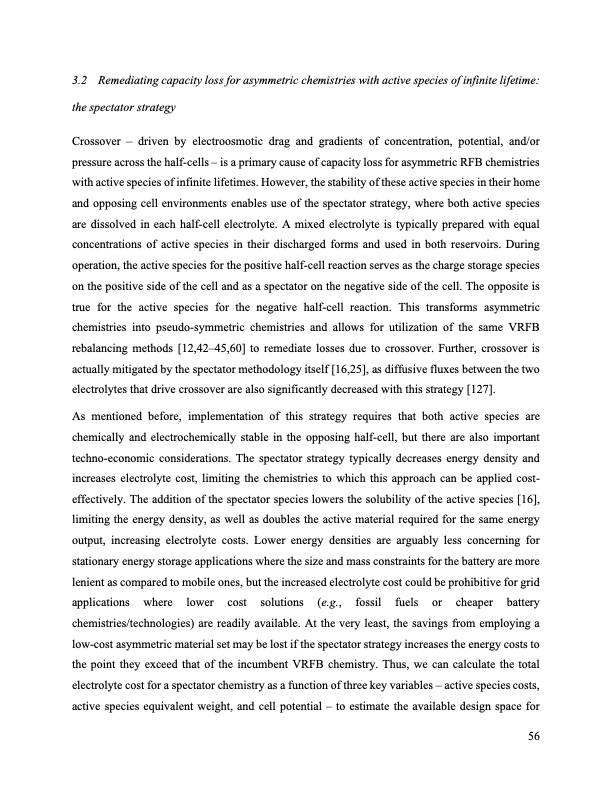
PDF Publication Title:
Text from PDF Page: 056
3.2 Remediating capacity loss for asymmetric chemistries with active species of infinite lifetime: the spectator strategy Crossover – driven by electroosmotic drag and gradients of concentration, potential, and/or pressure across the half-cells – is a primary cause of capacity loss for asymmetric RFB chemistries with active species of infinite lifetimes. However, the stability of these active species in their home and opposing cell environments enables use of the spectator strategy, where both active species are dissolved in each half-cell electrolyte. A mixed electrolyte is typically prepared with equal concentrations of active species in their discharged forms and used in both reservoirs. During operation, the active species for the positive half-cell reaction serves as the charge storage species on the positive side of the cell and as a spectator on the negative side of the cell. The opposite is true for the active species for the negative half-cell reaction. This transforms asymmetric chemistries into pseudo-symmetric chemistries and allows for utilization of the same VRFB rebalancing methods [12,42–45,60] to remediate losses due to crossover. Further, crossover is actually mitigated by the spectator methodology itself [16,25], as diffusive fluxes between the two electrolytes that drive crossover are also significantly decreased with this strategy [127]. As mentioned before, implementation of this strategy requires that both active species are chemically and electrochemically stable in the opposing half-cell, but there are also important techno-economic considerations. The spectator strategy typically decreases energy density and increases electrolyte cost, limiting the chemistries to which this approach can be applied cost- effectively. The addition of the spectator species lowers the solubility of the active species [16], limiting the energy density, as well as doubles the active material required for the same energy output, increasing electrolyte costs. Lower energy densities are arguably less concerning for stationary energy storage applications where the size and mass constraints for the battery are more lenient as compared to mobile ones, but the increased electrolyte cost could be prohibitive for grid applications where lower cost solutions (e.g., fossil fuels or cheaper battery chemistries/technologies) are readily available. At the very least, the savings from employing a low-cost asymmetric material set may be lost if the spectator strategy increases the energy costs to the point they exceed that of the incumbent VRFB chemistry. Thus, we can calculate the total electrolyte cost for a spectator chemistry as a function of three key variables – active species costs, active species equivalent weight, and cell potential – to estimate the available design space for 56PDF Image | Bringing Redox Flow Batteries to the Grid

PDF Search Title:
Bringing Redox Flow Batteries to the GridOriginal File Name Searched:
Rodby-krodby-phd-chemE-2022-thesis.pdfDIY PDF Search: Google It | Yahoo | Bing
Salgenx Redox Flow Battery Technology: Salt water flow battery technology with low cost and great energy density that can be used for power storage and thermal storage. Let us de-risk your production using our license. Our aqueous flow battery is less cost than Tesla Megapack and available faster. Redox flow battery. No membrane needed like with Vanadium, or Bromine. Salgenx flow battery
| CONTACT TEL: 608-238-6001 Email: greg@salgenx.com | RSS | AMP |